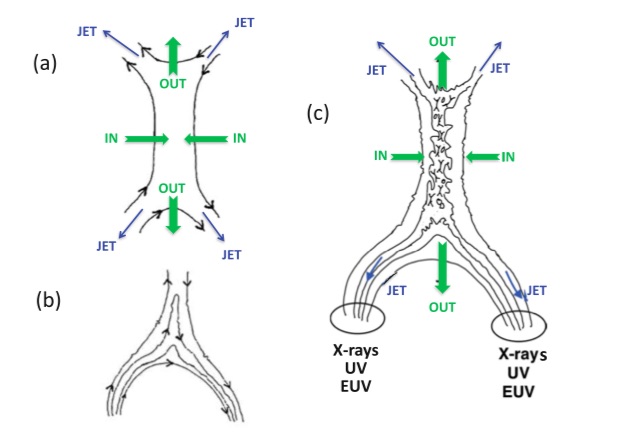
Cairns, I. H., V. V. Lobzin, A. Donea, S. J. Tingay, P. I. McCauley, D. Oberoi, R. T. Duffin, M. J. Reiner, N. Hurley-Walker, N. A. Kudryavtseva, D. B. Melrose, J. C. Harding, G. Bernardi, J. D. Bowman, R. J. Cappallo, B. E. Corey, A. Deshpand e, D. Emrich, R. Goeke, B. J. Hazelton, M. Johnston-Hollitt, D. L. Kaplan, J. C. Kasper, E. Kratzenberg, C. J. Lonsdale, M. J. Lynch, S. R. McWhirter, D. A. Mitchell, M. F. Morales, E. Morgan, S. M. Ord, T. Prabu, A. Roshi, N. Udaya Shankar, K. S. Srivani, R. Subrahmanyan, R. B. Wayth, M. Waterson, R. L. Webster, A. R. Whitney, A. Williams, and C. L. Williams, Low Altitude Solar Magnetic Reconnection, Type III Solar Radio Bursts, and X-ray Emissions, Scientific Reports, 8, 1676 (2018) (ADS)

(click on the image for a larger version)
Date: 2019 December 11
A view of the CSHKP model in support of interpretation of modern [1] low-frequency radio observations. One interesting aspect of the cartoon here is its clear "prediction" of not one, nor two, but four jet features associated with the plasmoid eruption. This would also have been noted in the Aschwanden-Benz cartoon supporting the occasional detection of reverse-slope type III bursts (in such a case, two jets, not four). The paper acknowledges this four-jet prediction by saying "plasma inhomogeneities and spatial asymmetries may lead to jets being observably different and even unobservable", which seems a bit like a waffle given that even the two-jet manifestation is quite rare. As noted elsewhere, it is surprising to see these 2D CSHKP-style cartoons still appearing at this late date.
MWA